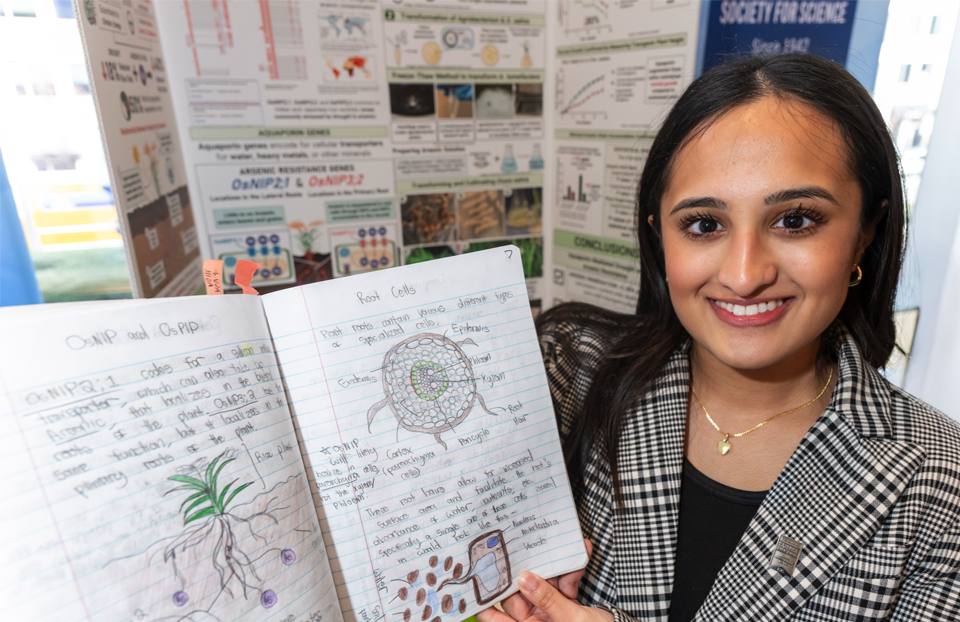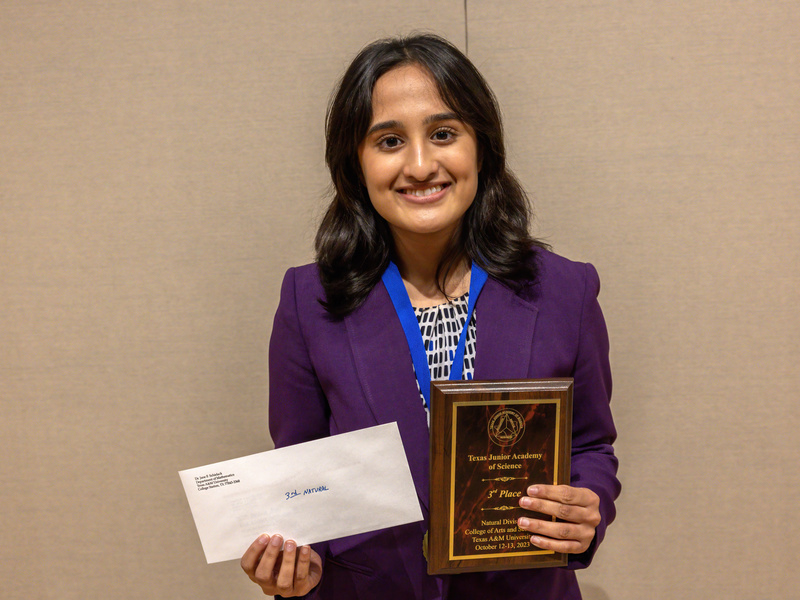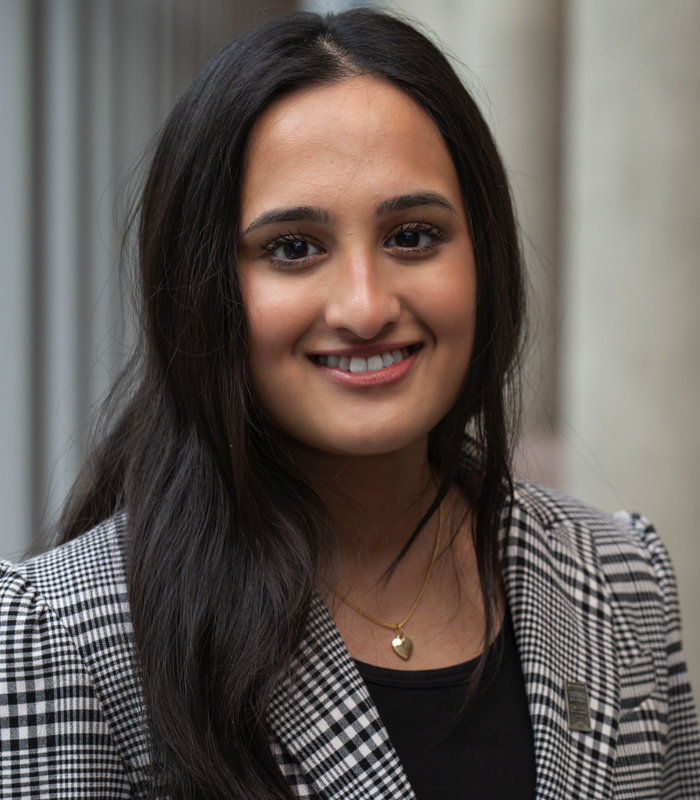(April 25, 2025) When Prisha Prakash Bhat visited her ailing grandmother in India a few years ago, she discovered a shocking culprit behind the illness: chronic arsenic poisoning from rice. In parts of India and other South Asian countries, rice can absorb arsenic from contaminated groundwater used for irrigation, accumulating the toxic element in its grains. The realisation that a staple food had silently harmed her loved one profoundly changed Bhat’s perspective. Determined to prevent others from suffering the same fate, the Indian-American teen resolved to channel her love of science into a solution for safer, healthier rice.
She engineered a variety of rice (Oryza sativa) that would trap arsenic in its roots instead of its grains – this breakthrough earned her a spot as a 2025 Regeneron Science Talent Search finalist.

Prisha Bhat
Engineering Rice to Resist Arsenic and Drought
Back home in Plano, Texas, Bhat “started looking for ways that [she] could remediate those toxic chemicals from the soil through natural means”. She set out to genetically alter common rice plants so they would act “like a sponge” – drawing arsenic out of the soil and trapping it in the roots, instead of letting it seep into the rice grains humans eat. After years of research and experimentation, she developed a promising solution. She rewrote the rice’s “instruction manual” so it could do two things at once: survive dry spells and lock arsenic away in its roots instead of in the part we eat. In experiments, this new rice stayed healthy during drought and its grains had almost no arsenic—meaning much safer rice for everyone.
Her project—tweaking rice so it survives droughts and locks arsenic in its roots—earned her a spot among the 40 Regeneron finalists. Rice feeds half the world, yet in many regions it’s grown with too little water or in arsenic-contaminated fields, putting millions at risk. By creating rice that needs less water and keeps arsenic out of the part we eat, Bhat is pointing the way to safer, more reliable food.
“I engineered rice to act like a sponge,” she explains, “so it pulls arsenic from the soil but stops it from reaching the grains. It’s a dual-purpose fix.”
Bhat sees her rice as part of a bigger mission: making food safer and crops stronger around the world. Inspired by Norman Borlaug—the scientist who helped end hunger with better farming methods—she hopes her droughtproof, arsenic-blocking rice will one day support small farmers in rural India, where her family comes from. It’s a personal project with the power to solve problems that have lasted for generations.


From Early Curiosity to Scientific Achievement
Bhat’s path has been driven by a lifelong curiosity about how things work. “STEM fascinated me from an early age,” she says on her nonprofit’s website, recalling that she entered science fairs at every level—from local to international—with projects on plants and the environment. Those competitions taught her the hands-on research skills she later used in her rice experiments. By high school, she wasn’t just doing her own advanced studies; she was also leading her peers. As president of her school’s science research club, she guided younger students, creating a supportive space where everyone could explore and learn together.
Outside the lab, Bhat also honed skills that have made her a well-rounded scientist and advocate. She led her high school speech and debate team, which taught her how to explain tricky science in clear, relatable terms. She also volunteered at a regional poison control center to help people exposed to toxins and even organized a local art exhibit to spotlight everyday environmental dangers—experiences that shaped her into a confident communicator and community-minded leader.


Her passion for combining science with social good inspired her to start a youth-led nonprofit called Empower Earth. “Growing up in Dallas, where minorities and the poor often face unfair treatment, I became driven to fight for social equity,” she explains. Through Empower Earth, she’s led efforts like planting trees in underprivileged neighborhoods to improve “tree equity” and running community workshops on everyday environmental hazards. This same commitment guides her rice project—it’s all part of protecting vulnerable communities from toxins, whether in Texas or thousands of miles away in South Asia.
An Indian-American STEM Story
Prisha’s story is also part of a bigger trend: in 2025, 13 of the 40 Regeneron finalists were Indian-American teens, showing how strongly this community values education and innovation. Her work bridges two worlds—she drew on her roots in rural India to spot a problem, then used American research resources to solve it. Like many children of immigrants, she blends respect for her heritage with a drive to excel, joining a growing group of young Indian-Americans who bring their unique perspectives to scientific discovery.
Bhat credits her success to a strong support network—from teachers who fueled her curiosity to her parents, who emigrated from India and always backed her education. Joining the ranks of other high-achieving Indian-American students as a Regeneron finalist is a proud milestone. The Society for Science says this year’s finalists are shaping up to be tomorrow’s leaders in tackling global challenges. For Bhat, the honor is also a springboard for what comes next.
At 18, Prisha is heading to college this year but will keep focusing on safer, more sustainable farming and public health. She plans to perfect her rice project and move it from the greenhouse into real fields. Her mission is simple: make sure no one else suffers like her grandmother did. With her dedication and creativity, she’s already paving the way to safer food for everyone, one grain at a time.
- Follow Prisha Prakash Bhat on LinkedIn
ALSO READ | Shield Seniors: How Dallas teen Tejasvi Manoj is using AI to protect elderly from online scams




